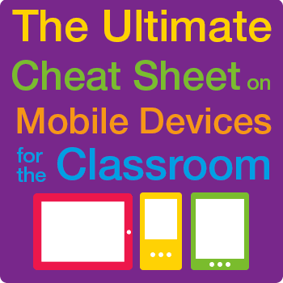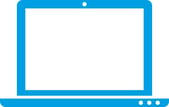 Ever wonder what the difference really is between a smartphone and a tablet?
Ever wonder what the difference really is between a smartphone and a tablet?
When it comes to the mobile devices that can be used in today's classrooms, there are so many different options that it makes you wonder what the real differences are between them. This Cheat Sheet provides a snapshot of the different device types currently on the market, and offers insight into the pros and cons of using these devices in the classroom.
 |
|
Popular Brands: iPhone, Samsung Galaxy, Motorola Moto X, HTC One, and LG Optimus |
The Smartphone
What It Is: Smartphones are mobile phones that can run educational applications, record audio and video, and send email and text messages. Also in this category are “non-phone” smart devices (such as the iPod touch), which have all of the functionality of a smartphone minus phone and mobile broadband (data) capabilities.
Pros: Most students already own smartphones, so they are perfect for BYOD (bring your own device) classrooms.
Cons: For consuming media and material, the screen size can be limiting, and it is difficult to view any detailed content.
 |
|
Popular Brands: Amazon’s Kindle, the Sony Reader, Borders’ Kobo, and B&N Nook |
What It Is: E-book readers are primarily used for reading books, newspapers, and magazines. Some (but not all) e-readers offer Internet connectivity and other high-end functionality.
Pros: They are lighter than most tablets and are very comfortable to read, especially for longer periods of time or in the sunlight.
Cons: The functionality of some e-readers is limited to displaying reading material.
 |
|
Popular Brands: iPad, Google Nexus, Samsung Galaxy Note, Sony Xpeia, and Microsoft Surface. |
The Tablet
What It Is: Tablets are highly portable computing devices, with a larger screen than e-readers and smartphones. They are capable of doing any task that an e-reader or smartphone can do, but do not have the processing power of a laptop.
Pros: Tablets are small and light and can fit easily into a student’s backpack. The screen size makes it easy to view class materials, take notes, and create content. You can directly touch the screen using your finger or a stylus, providing a more tactile experience than a mouse does for drawing and illustrating.
Cons: Their functionality as a computing device is very limited. They are costly, and you must take special precautions in the care of the touchscreen display. While protective cases are available, they require a separate purchase.
 |
|
Popular Brands: Samsung Chromebook, Acer Chromebook, and HP Chromebook
|
The Chromebook (Thin Client Laptop)
What It Is: A Chromebook is a personal computer that runs Chrome OS as its operating system. Like other thin client laptops, Chromebooks are designed to be used while connected to the Internet; they support applications that reside on the Web (such as Gmail, Google docs, etc.), rather than traditional applications that reside on the machine itself. All the data is stored in the “cloud,” and accessed via an Internet connection.
Pros: They cost a fraction of the price of a laptop, and have a full-sized keyboard to enter in notes in the classroom. They support many USB devices, such as cameras, mice, external keyboards, and flash drives.
Cons: They offer only a handful of applications that will work offline.
 |
|
Popular Brands: Apple MacBook, Acer Aspire, Dell Latitude, Sony Vaio Pro, and Lenovo ThinkPad
|
What It Is: Laptops are portable Macs/PCs. They are larger and heavier than all of their mobile counterparts, but also much more powerful. They can run a desktop operating system. Laptops have a built-in keyboard and mouse (or track pad), and they work both online and offline.
Pros: Laptops can run all popular desktop applications, including Word, PowerPoint, and Excel, as well as mainstream games. Nothing is faster for creating content than a laptop used with a keyboard and mouse.
Cons: They are the largest and heaviest mobile devices, and they are costly.
As the numbers of mobile devices on the market grow, the devices are becoming more and more affordable for students and for your school. Using these devices in the classroom makes learning more engaging for students, and allows them to work today with the tools that will shape tomorrow.
Already own or use mobile devices in the classroom? Want to learn how to truly love them more?
Check out the webinar "How to Fall in Love with Your Mobile Devices" hosted by Roland Rios, Director of Technology for the Ft. Sam Houston Independent School District in San Antonio. He will discuss tips and suggestions for how to use your mobile devices in the classroom—from assessment to collaboration. Get ready to fall in love with all your mobile devices!



